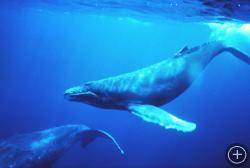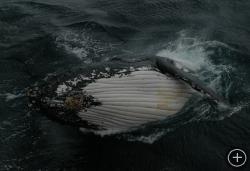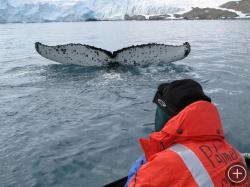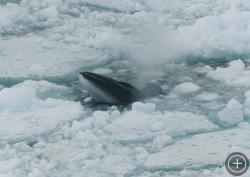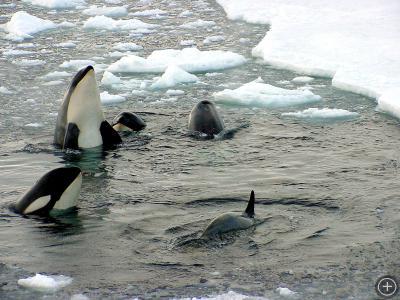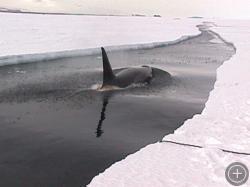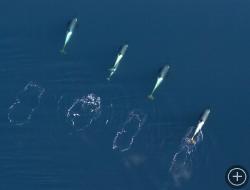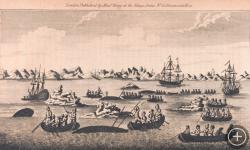Antarctic Whales
Drawn to the cold, nutrient-rich Antarctic waters, ten species of whales spend their summers at the bottom of the world. Often sighted by research scientists are the humpback, minke, and orca.
Humpbacks
Humpbacks are best known for their haunting songs—a sequence of squeaks, roars, moans, and whistles that, analysts say, contain rhyme, rhythm, and other elements found in human music. A song can last about twenty minutes (and may be repeated for hours), reaching an audience as far as twenty miles (32 km) away. It’s generally believed that only the males sing, and it appears that they sing primarily in their breeding grounds, so an early assumption was that these are songs of courtship. But further research showed that males, not females, are attracted to the singer, which calls the courtship idea into question.
All the whales in a particular population sing the same song, which evolves over time: Certain parts of the previous year’s song are omitted while new parts are added. This pattern of change has led some people to speculate that the songs are a form of oral history—an appealing idea, but one that seems impossible to prove or disprove. It’s likely we may never know the meaning of their captivating music.
Humpback song, courtesy of NOAA.
If being the opera stars of the ocean wasn’t enough claim to fame, humpbacks are also accomplished acrobats. They can propel their 50-foot-long (15 m) bodies out of the water (called breaching), sometimes twirling around before falling back into the sea with a loud crash. They can lift about a third of their body vertically out of the water (spyhopping) to take a look around. They may also slap their tail repeatedly on the water (lobtailing or fluke slapping), or slap the water with a fin. The reasons for these behaviors aren’t known, but observers find them enchanting. As marine science graduate student Cassandra Brooks wrote in a dispatch from Antarctica in February 2008:
Humpbacks are especially curious whales, and some encounters are amazing. Two years ago we had a pair of humpbacks that seemed just as delighted in us as we were in them. The whales spy-hopped, breached, rolled and fluked within only a few meters of the boat, and we dashed from port to starboard side and back again to follow every move.
Another distinctive humpback behavior is bubble-net feeding, a cooperative hunting strategy that involves creating a “fishing net” out of bubbles. The whales form a circle up to 100 feet (30 m) wide below a group of prey, usually krill or a school of small fish, and then blow a cylindrical wall of bubbles that encloses the prey. Then they swim up through the net to the surface, gulping rich mouthfuls of food. Humpbacks are baleen whales, named for the hundreds of flexible plates, called baleen, that are attached to their upper jaws. The plates are filters that trap the whales’ prey. The more densely the prey are concentrated, the better it is for the whales, so it’s good, from the whales’ point of view, that the prey won’t attempt to swim through the bubbles.
Minkes
Although smaller, minkes are closely related to humpbacks. Both belong to the rorqual family of whales, also known as the “great whales,” all of which have a large number of pleats along their throats that expand while they’re feeding. There are at least two species of minkes: the common, or northern, minke and the Antarctic minke, with the dwarf minke considered a possible third. There are also several subspecies.
Minkes make a number of sounds, including clicks, grunts, thumps, and the interesting “boing” that was just identified as a minke vocalization in 2002. The sounds can vary from population to population and are helpful to researchers who study these animals.
The minke whale boing sound, courtesy of NOAA.
As acrobats, minkes are pretty much up to snuff. In the Antarctic summer, they’re seen spyhopping in the open pack ice, and they’re often observed breaching. Like their humpback cousins, minkes are curious, and they’ll often swim up to a ship to see what’s going on.
After a summer in the Antarctic, many minkes migrate to warmer northern waters to mate or to give birth to calves conceived the previous year. But some have been spotted in the middle of the winter pack ice where they apparently spend the season. Like other rorquals, they have rather pointed heads, which they stick up through narrow cracks in the ice to breathe.
Orcas
On display at marine parks throughout the world, and often the object of whale-watching expeditions, the beautiful black-and-white orca is one of the best-known cetaceans. It’s also called the killer whale—a name that may be derived from “whale killer” or “killer of whales” because some orcas hunt baleen whales. Orcas belong to the dolphin family, Delphinidae, and like other dolphins they have strong, sharp teeth that they use in hunting.
Highly social, orcas are generally found in pods, groups typically containing from a few to fifty individuals. It’s thought that they talk to each other primarily with whistles, squeaks, and squawks. They also produce click sounds that mostly, it’s believed, help them know what’s going on in the neighborhood. The clicks are reflected back from objects so the whales can be aware of, say, an iceberg that should be avoided or perhaps some seals that would make a tasty breakfast.
Orcas are found in all the world’s oceans, but they’re most abundant in Antarctica. It’s believed that they tend to move northward in the winter, but they don’t have set migratory routes, and orcas have occasionally been seen amid the pack ice in midwinter.
Three distinct groups of orcas, known as ecotypes A, B, and C, have been observed in Antarctic waters. They’re distinguished from one another by differences in size, coloring, and dietary preferences.
Type A orcas go after the really big prey, primarily minkes, but larger baleen whales as well. Male type A orcas may grow to about 32 feet (10 m), about the same size as a minke but smaller than humpbacks and significantly smaller than the blue whale, the largest of them all at over 80 feet (25 m). The orcas’ strategy is to hunt in packs, which has earned them the nickname “wolves of the sea.”
Type B orcas fancy seals and penguins, while type C orcas dine mostly on fish. Interestingly, this puts penguins in danger of predation from type B orcas—and puts them, especially the Adélie penguins, in competition with the minkes for krill and in competition with the type C orcas for fish. As penguin researcher David Ainley noted in his dispatch from November 2007:
When the minke whales arrive in larger numbers, and the type-C killer whales, too, we can expect the penguins to have more difficulty finding food. These whales go after the same food as the penguins, and take much more of it in one gulp!
Past and Present
Humpbacks were hunted mercilessly, but they’re slowly recovering. Still, the population is estimated at only about 30,000 worldwide.
The minke population in the Southern Hemisphere seems healthy right now, with perhaps a million animals. Because of their relatively small size, about 32 feet (10 m) in length, they were ignored during the height of commercial whaling. And the decline of other baleen whale species due to hunting left more food for them. They’re hunted today, though: Japan issues scientific permits for killing several hundred Antarctic minkes every year. Many people think that this is simply a way to circumvent the moratorium on commercial whaling that’s been in place since 1985-86. And many scientists find it particularly disturbing when whaling (or fishing) is conducted in the Ross Sea, which is one of the last truly functional marine ecosystems in the world.
Orcas, like the minkes, escaped the horrors of commercial whaling. Their numbers in the Antarctic are thought to be about 70,000. But as top predators, orcas are particularly affected by chemical contaminants such as PCBs, and some people feel that live capture by marine parks and other institutions also harms the species.
Future
All these whales may face a serious threat if global warming causes a significant loss of sea ice. If that happens, it’s anticipated that the shrimplike krill will be in short supply—and at a time when krill are being caught in increasing numbers by commercial fisheries. This will be bad news for the humpbacks and minkes, as well as penguins, seals, and other predators that compete for these nourishing little morsels. And indirectly this will affect the orcas as well.


